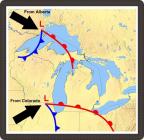1
Main Beach in Goderich9 November 2008
Lake Huron, Goderich, Ontario, Canada
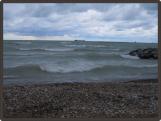 Credits:
Credits:Huron County Museum, Goderich, Ontario, Canada
3
The Great Storm of 1913 was the result of two storm systems colliding over Lake Superior. The storm started on November 6 and finally subsided on November 11. On November 7th, the storm was mainly affecting Lake Superior with gale-force winds. It was also on this day, at 10:10 AM, that the Dominion Weather Observatory in Toronto ordered storm signals to be put up at all ports from Fort William to Kingston, Ontario. In total, warning signals were flying at most of the 100 ports all across the Great Lakes. The storm warnings posted were a level 4, the highest possible warning on the Great Lakes, standing for a heavy gale.By November 8, the storm was making its way down to Lake Huron and increasing in intensity. This system was a massive Arctic Cold Front and it was moving quite rapidly southward. It was here it collided with warm, moist winds from the Gulf of Mexico. Also at this time, however, there was a false lull in the storm, leading many Captains to believe that the storm may be abating. The forecast for November 8th that was issued by the U.S. Weather Bureau was "snow or rain and colder Saturday, with west to southwest winds. Sunday unsettled".
November 9th saw the storm reach its pinnacle. In the early stages, the storm produced winds averaging 35 to 40 miles per hour over Lake Superior. Once the storm was in full force, however, winds of up to 140 kilometers per hour (90 miles per hour) ravaged the Great Lakes, especially Lake Huron, which is where the storm was at its worst. The storm had a counter clockwise rotation and near its centre, which was over Lake Huron, the winds were at their fiercest and were constantly changing direction.
On Monday, November 10th, the storm was moving eastwards and by November 11th, without the warm waters of the Great Lakes, the storm finally disipated.
6
Storm Warning Configurations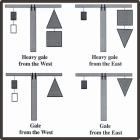 Credits:
Credits:Huron County Museum, Goderich, Ontario, Canada
Bruce County Museum & Cultural Centre, Southampton, Ontario, Canada
7
Great Storm of 1913 ShipwrecksNovember 1913
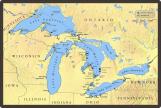 Credits:
Credits:Wikipedia User: brian0918 (http://en.wikipedia.org/wiki/user:brian0918)
U.S. Geological Survey
8
When it was over, the Great Storm sank a total of twleve ships and caused six others to be so badly damaged they were rendered useless. Of these thirteen, eight sank in Lake Huron: the John A. McGean, Regina, Isaac M. Scott, Wexford, Charles S. Price, Hydrus, James Carruthers, and the Argus. The Henry B. Smith and the Leafield sank in Lake Superior. The Plymouth sank in Lake Michigan. Lightship No. 82 sank in Lake Erie. No boats sank in Lake Ontario during the Great Storm of 1913. Six other vessels ran aground during the storm and were deemed to be total losses by their respective companies.A question on the minds of many at the time and even still to this day is why would so many vessels be out in such ferocious weather? Unlike today, weather reports and warnings were not as readily available nor were weather patterns and storm systems that well understood. Vessels also were not equipped with radios, hindering them from receiving the latest weather reports while they were out on the lakes. Storm warnings for heavy gales were posted on the morning of November 7th, after an alert was issued from the weather service. These warnings were actually a series of wicker baskets, flags and lights (to be seen at night). These indicated the anticipated strength and direction of the wind. This heavy gale warning, the highest warning that could be posted on the Great Lakes, remained in place along all ports in Ontario until November 11. Ports along the U.S. side of the Great Lakes carried the same warning. The downfall to these warnings, however, was that they did not give an estimated time to when the storm would actually hit. During the inquest into the Great Storm held in Goderich at the end of November 1913, it was revealed that for this reason, many sailors did not like to rely on these warnings. With November being close to the end of the shipping season , there was a rush to get these last cargos delivered. Not knowing when a storm was going to hit, despite warnings being posted, caused many Captains to take a chance with the weather and attempt to make their next port hoping to beat the storm.
It was also revealed during the Inquest that many Captains relied on their barometers more than weather reports and warnings. If the barometer was staying stable or on its way up, it was assumed the weather would remain fair. If the barometer was on its way down, that meant a storm. In the case of the Great Storm, the barometer at one point began to rise. There was also a lull in the storm, causing many Captains to believe the worst was over and they would be able to make their next port. Nobody could have predicted how dangerous the storm would become. With the false hope caused by the lull in the storm, a rising barometer for a brief period of time, lack of reliable storm warnings and understanding of the weather, many ships were caught in what became known as the "white hurricane".
9
Bodies washed ashore at GoderichNovember 1913
Lake Huron, Goderich, Ontario, Canada
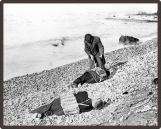 Credits:
Credits:Historical Collection of the Great Lakes, Bowling Green State University, Bowling Green, Ohio, U.S.A.
10
On November 11th, bodies of victims of the Great Storm began to wash ashore on both the Canadian and American sides of Lake Huron. The first body recovered was that of James Glenn, a sailor from the Wexford. Bodies continued to drift ashore for over a week up and down the Lake Huron coast. Many were wearing life jackets and others came ashore in lifeboats.The mayor of Goderich had to order police patrols along the shoreline due to looting of the bodies. Bodies were brought to the Brophy Funeral Home, located on West Street.
11
The body of Mrs.William Walker , a second cook on one of the ship's the sank, washed ashore in the days following the storm. She was wrapped in a heavy coat belonging to the ship's engineer . She was also wearing the Captain's life preserver. Paul Hutch, the Captain, was later found without a life preserver.12
Retrieving bodies washed ashoreNovember 1913
Lake Huron
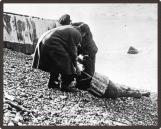 Credits:
Credits:Historical Collection of the Great Lakes, Bowling Green State University, Bowling Green, Ohio, U.S.A.
